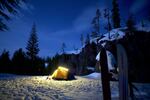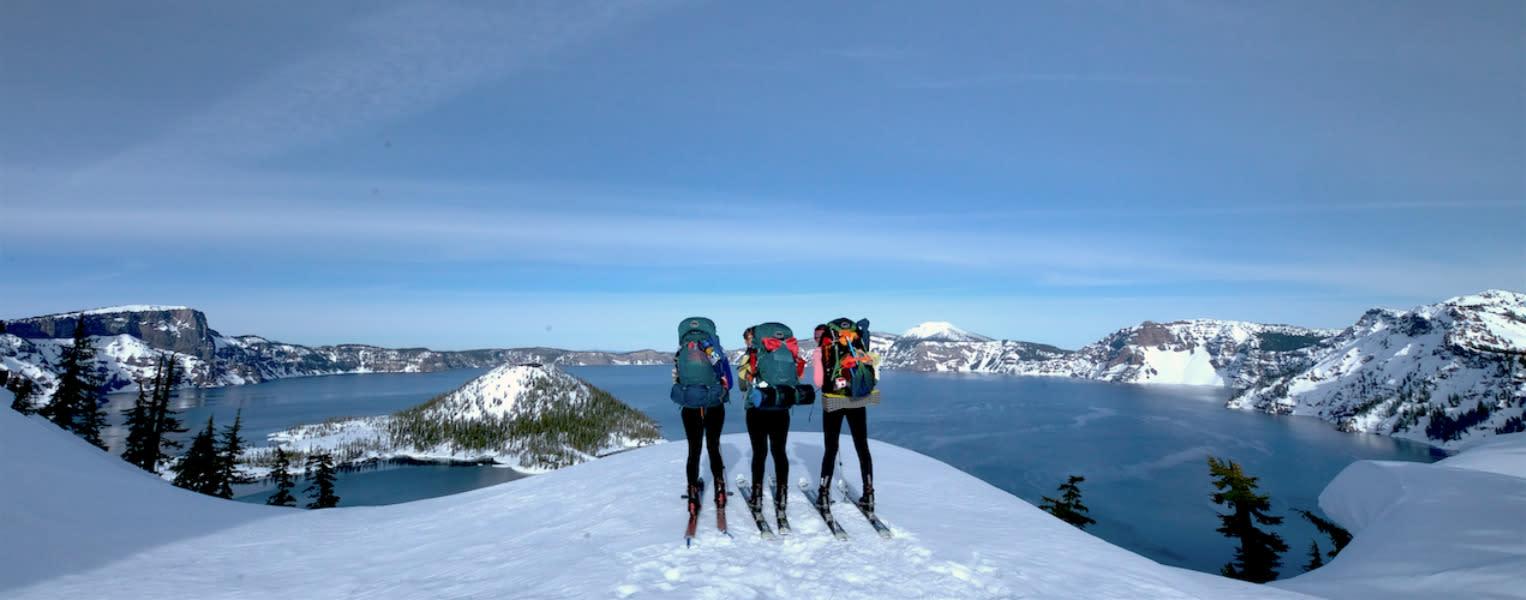In summer, cars crammed with children and camping gear, RVs and touring motorcycles slowly motorcade around Crater Lake’s 33-mile Rim Road. But during the depth of winter, the road is closed, buried in snow. The only way around Crater Lake is by ski or snowshoe.
During the summer, it takes an hour to make the loop, maybe more, depending on traffic and number of stops at overlooks to snap selfies and behold the radiant blue water. So it might seem like skiing around the lake would be a relatively flat, easy glide. In reality, it can be a grueling, multi-day trek that can test even the hardiest outdoor adventurers.
This is why we’ve come.
Three outdoor enthusiasts — Jan Zarella, Kelsey Hinds, and Jess Barton — plan to circumnavigate the lake on skis. A small crew from "Oregon Field Guide," including me, is here to film their trip.

"Oregon Field Guide" filming on location in Crater Lake National Park.
Ian McCluskey / OPB
In the winter months, the glimmering lake becomes grey and moody — its true mountain nature revealed.
Before Crater Lake was a lake, it was the highest peak in Oregon — Mount Mazama. When it erupted thousands of years ago, it lost nearly a mile of its height (spreading ash across North America). What remains is a jagged ring of snowy crags, sharp pinnacles, ice cornices and sheer cliffs. Although no longer the tallest Cascade peak, the rim rises 7,000 to 8,000 feet in elevation, higher than Silcox Hut above Timberline Lodge.

The crew sets off around Crater Lake by ski. Wizard Island is visible in the background.
Ian McCluskey / OPB
We arrive to find brilliant sun gleaming off the fresh snow. The parking lot is full. Dozens of families snowshoe and ski a few miles north of the lodge to an overlook of Wizard Island and back. It’s a relatively easy day trip. But to go farther, around the peak called the Watchman, means stepping into winter wilderness conditions. Once you get more than a day out, you’ve committed. There are no shortcuts back.
“We’re risking hypothermia, frostbite even, and if it takes us more time and a storm rolls in early, we’re stuck out there,” explains the trip leader, Jan.
Jan personally knows two skiers who got caught in a storm and were stranded for several days. A couple months before, three visitors were trapped at the Rim Village parking lot for a week, seeking shelter in the heated bathroom.
Our window of time is short. The snow and ice this winter have been 150 percent above average, often making the route impassable. In four days, another major storm is predicted to roll in.
Watch The Full 'Oregon Field Guide' Story
We’ve packed extra food, extra fuel, extra clothes, avalanche probes, beacons, shovels and a satellite phone.
“But no matter how much you prepare,” Jan says, “you’re not really prepared for what the trip can throw at you.”
As we ski clockwise around the lake, we soon begin to climb toward the Watchman. The trail narrows. To one side, cliffs tower above us, laden with snow, threatening avalanche. On the other side, far below, we peer down onto the tops of pine trees.
"The terrain acts as a filter," Backcountry Office Supervisor Heidi Barker explains. "People get to the Watchman and realize it is super scary, and if they don't feel prepared, they turn back."
The snow has filled in the road, leaving only a sheer slope of snow and ice. Ben, a cameraman for "Oregon Field Guide," shakes his head. “It’s crazy to think RVs drive here in summer!”

The road around the Watchman in winter doesn't look much like a road.
Ian McCluskey / OPB
Rounding the Watchman puts us on the north rim of the lake, which is all the more remote in winter. The north entrance of Crater Lake National Park is closed during the season. Nearly all traces of human use have been erased by snow. The road undulates in snowdrifts as tall as houses.
Of the places where snowfall is recorded, Crater Lake is one of the snowiest in the world. In a typical winter, it gets 533 inches of snowfall — over 44 feet.
We stop and consult the map. Kelsey and Jan point to the various lookout points along the road — we’re not sure which ones we skied right over.
“We’re somewhere around the Mazama Rock,” Jan estimates.
“Is that the Mazama Rock?” Kelsey asks, looking up at a towering stone silhouetted in the moonlight.
“I don’t know,” says Jan, looking up. “It’s a pretty big rock!”
Exhausted, sore and hungry, we are in no shape to press on. We stop in our tracks and set up camp — literally in the middle of the road.

A busy road in summer becomes an isolated wilderness camp in winter.
Ben Canales / Uncage The Soul Productions
Reaching the halfway point, we are far from help in either direction. After two nights sleeping and cooking and traveling in a world of snow and trees, we finally feel the release of “lowland duties,” as John Muir called them— the fray of modern, urban life we temporarily left.
For a fleeting moment, we feel like we have an entire national park to ourselves.
National Parks have seen record numbers of visitors, and Crater Lake is no exception. For the past seven years, visitation statistics have soared. From 2014 to 2015, numbers increased 13.5 percent. From 2015 to 2016, numbers increased again by 23 percent, putting the total number of visitors that year to 756,344.
The winter trek around the lake has become more popular and less isolated.
"It used to be that only the brave and bold did it," says Ranger Barker. "Now everyone wants to do it."
According to data the Backcountry Office has been collecting, the average number of people in the park per night in winter has more than doubled over the last couple years.
But it will always remain earned through physical effort.

Skiing high into the clouds as a storm rolls in.
Ian McCluskey / OPB
Headed higher into the clouds to wrap around the Mount Scott pass, we ski uphill for miles. Our legs ache. Blisters rub raw.
Then the sky darkens. The predicted storm is coming. It begins to spatter us with icy rain.
We lose the trail and end up on a steep forest slope. We have to weave between the trees — challenging enough on downhill skis, but with cross-country skis it's even harder.
We find the road again, but it is blocked by a recent avalanche. Cliffs tower a thousand feet above, draped with snow and ice.
To avoid the avalanche zone, we must leave the road, and drop down into the trees. There is no trail to follow, only Jan’s internal compass. We slip, slide, and fall down the hill.
When we fall, we sink, and struggle to push ourselves back up with poles. Jess’s pole bends and her pole basket comes off.
We reach the campground by dusk, wet and cold. To make a shelter to cook under we string a tarp between pines, poked up with an avalanche probe.
At dawn, our tents are covered in sheets of wet snow and ice. Jan’s sleeping bag, wedged against the side of her tent, is soaked.
“I think I speak for all of us,” she says. “We are ready to be done.”
The ski out is slow and soggy. Hours pass with few words, the only sounds are the squeak of bindings and boots, the whistling of wind through the trees, and the patter of snowflakes on hoods and eyelashes.

Skiing the final miles in sleet.
Ian McCluskey / OPB
The three women are each at the peak of physical condition. They are long-distance runners, long-distance bicyclists, rock climbers and mountaineers. On any given day, each of them could compete in a triathlon. And yet, they are reaching their limits.
Jan suddenly faceplants.
Rattled from the fall, she looks down and notices her ski has popped off. Then she notices the reason: the cable of her binding snapped.
For months, Jan had made lists. She’d packed extra everything, even a homemade apple pie. She stares at her broken binding, angry at herself for not anticipating this equipment failure.
Jake, part of the "Oregon Field Guide" team, pulls out bailing wire and a zip tie and rigs the binding as best he can.
“Well,” says Jan, looking down. “Let’s see if this will hold.”
With the short winter daylight already fading fast and more than 5 miles to go, we press onward.
The wind blows the rain sideways. The storm is closing down on the park. With food reserves almost gone, stove fuel low, and Jan’s wet tent and sleeping bag, we can’t risk getting trapped in the backcountry by the storm.
At last, we return to where we had first set off. The sky is inky black. The wind howls.
The clouds peel back just enough to look down into the lake. The wind blows white caps.
Blisters sting, and legs wobble in fatigue, but we feel a bleary elation of accomplishment and appreciation. We stand, arms around each other, shivering and smiling.
“— John Muir"And when we at length go down the long white slopes to the levels of civilization, the pains vanish like snow in sunshine, while the noble and exalting pleasures we have gained remain with us to enrich our lives forever."”

Returning to the starting point of the journey, after four days and some 40 miles of skiing.
Ian McCluskey / OPB

